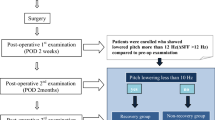Abstract
Decreased high pitch after thyroidectomy due to injury of the external branch of superior laryngeal nerve (EBSLN) may be a critical, especially to professional voice users. The author studied the usefulness of VRP (voice range profile) and MDVP (multi-dimensional voice program) to evaluate patients who have decreased high pitch after thyroidectomy. A study was performed with 58 females and 9 males who underwent voice assessment between January 2008 and June 2009. The patients were classified as the group of female with no decreased high pitch (group A, n = 52), decreased high pitch (group B, n = 6) and the group of male with no decreased high pitch (group C, n = 9). VRP and laryngeal electromyogram (EMG) was performed in group B. Results: The preoperative frequency range of group A and B were statistically not different. In Group B, the result of VRP showed that the frequency range was 443.11 ± 83.97, 246.67 ± 49.41, 181.37 ± 80.13 Hz showing significant decrease after the surgery compared to that of the preoperative result. (P < 0.05) In addition, the intensity range was 22.25 ± 2.87, 15.25 ± 2.22, 16.25 ± 2.63 dB respectively showing significant postoperative decrease. (P < 0.05) EMG of the cricothyroid muscle of group B showed decreased potential with 3 patients, normal potential in 2, and the other patient refused to take the examination. In group A and C, the result of VRP revealed no significant difference between the preoperative and postoperative result. VRP is a noninvasive, quick, and practical test to demonstrate decreased frequency range visually and helps to evaluate EBSLN injury in patient with thyroidectomy.





Similar content being viewed by others
References
Debruyne F, Ostyn F, Delaere P, Wellens W (1997) Acoustic analysis of the speaking voice after thyroidectomy. J Voice 11:479–482
Aluffi P, Policarpo M, Cherovac C, Olina M, Dosdegani R, Pia F (2001) Post-thyroidectomy superior laryngeal nerve injury. Eur Arch 258:451–454
Jansson S, Tisell LE, Hagne I, Sanner E, Stenborg R, Svensson P (1988) Partial superior laryngeal nerve (SLN) lesions before and after thyroid surgery. World J Surg 12:522–526
Cernea CR, Ferraz AR, Furlani J et al (1992) Identification of the external branch of the superior laryngeal nerve during thyroidectomy. The Am J Surg 164:634–639
Teitelbaum BJ, Wenig BL (1995) Superior laryngeal nerve injury from thyroid surgery. Head Neck 17:36–40
Lombardi CP, Raffaelli M, D’Alatri L et al (2006) Voice and swallowing changes after thyroidectomy in patients without inferior laryngeal nerve injuries. Surgery 140:1026–1034
Dursun G, Sataloff RT, Spiegel JR, Mandel S, Heuer RJ, Rosen DC (1996) Superior laryngeal nerve paresis and paralysis. J Voice 10:206–211
Randolph GW, Kamani D (2006) The importance of preoperative laryngoscopy in patients undergoing thyroidectomy: Voice, vocal cord function, and the preoperative detection of invasive thyroid malignancy. Surgery 139:357–362
Tanaka S, Hirano M, Chijiwa K (1994) Some aspects of vocal fold bowing. The Ann Otol Rhinol Laryngol 103:357–362
Soylu L, Ozbas S, Uslu HY, Kocak S (2007) The evaluation of the causes of subjective voice disturbances after thyroid surgery. The Am J Surg 194:317–322
Stojadinovic A, Shaha AR, Orlikoff RF et al (2002) Prospective functional voice assessment in patients undergoing thyroid surgery. Ann Surg 236:823–832
Robinson JL, Mandel S, Sataloff RT (2005) Objective voice measures in nonsinging patients with unilateral superior laryngeal nerve paresis. J Voice 19:665–667
Hirano M (1988) Vocal mechanisms in singing: laryngological and phoniatric aspects. J Voice 2:51–99
Ortega J, Cassinello N, Dorcaratto D, Leopaldi E (2009) Computerized acoustic voice analysis and subjective scaled evaluation of the voice can avoid the need for laryngoscopy after thyroid surgery. Surgery 145:265–271
de Pedro Netto I, Fae A, Vartanian JG et al (2006) Voice and vocal self-assessment after thyroidectomy. Head Neck 28:1106–1114
Author information
Authors and Affiliations
Corresponding author
Rights and permissions
About this article
Cite this article
Kim, S.W., Kim, S.T., Park, H.S. et al. Voice Examination in Patients with Decreased High Pitch after Thyroidectomy. Indian J Otolaryngol Head Neck Surg 64, 120–130 (2012). https://doi.org/10.1007/s12070-012-0516-7
Received:
Accepted:
Published:
Issue Date:
DOI: https://doi.org/10.1007/s12070-012-0516-7



